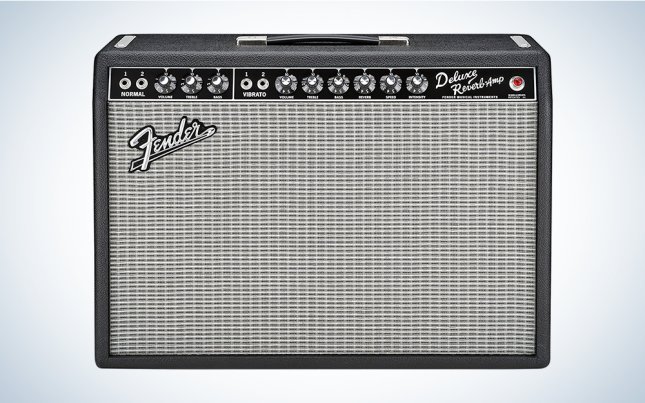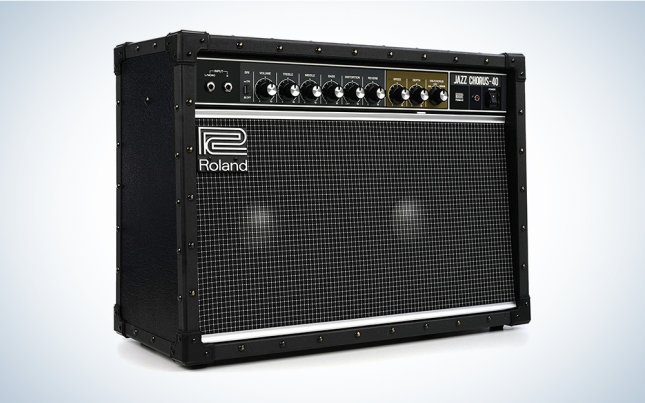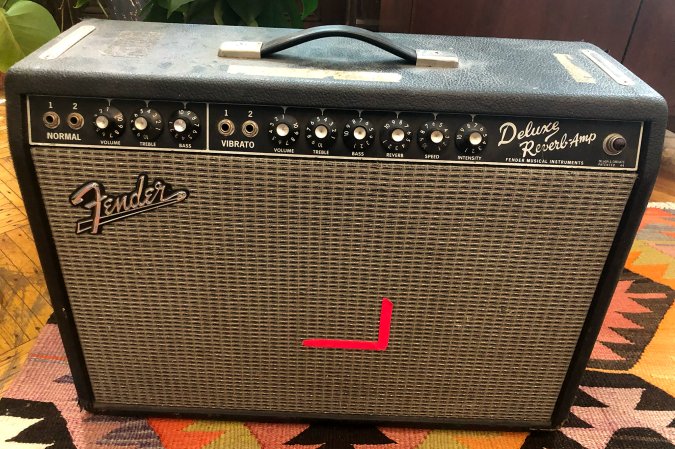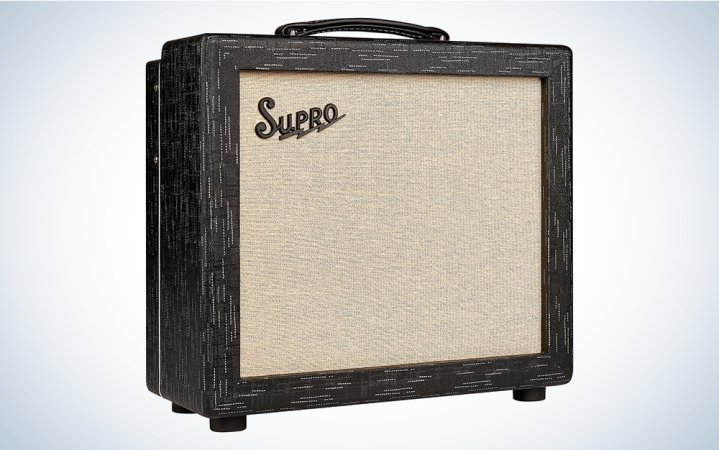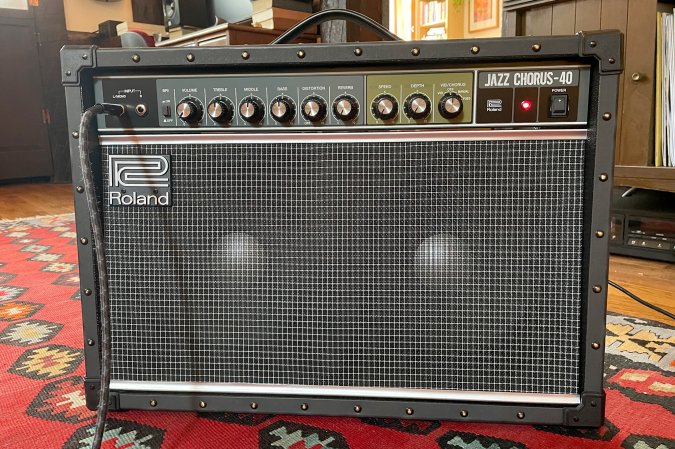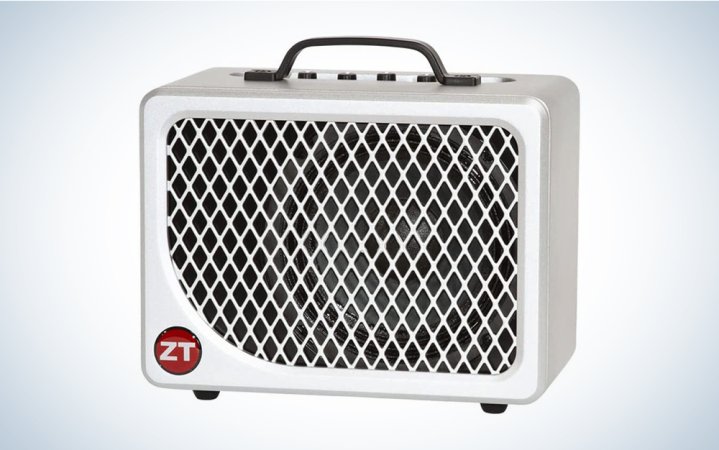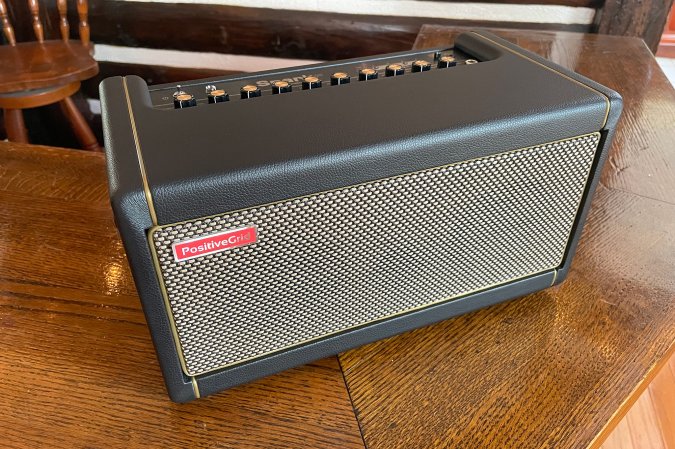We may earn revenue from the products available on this page and participate in affiliate programs. Learn more ›
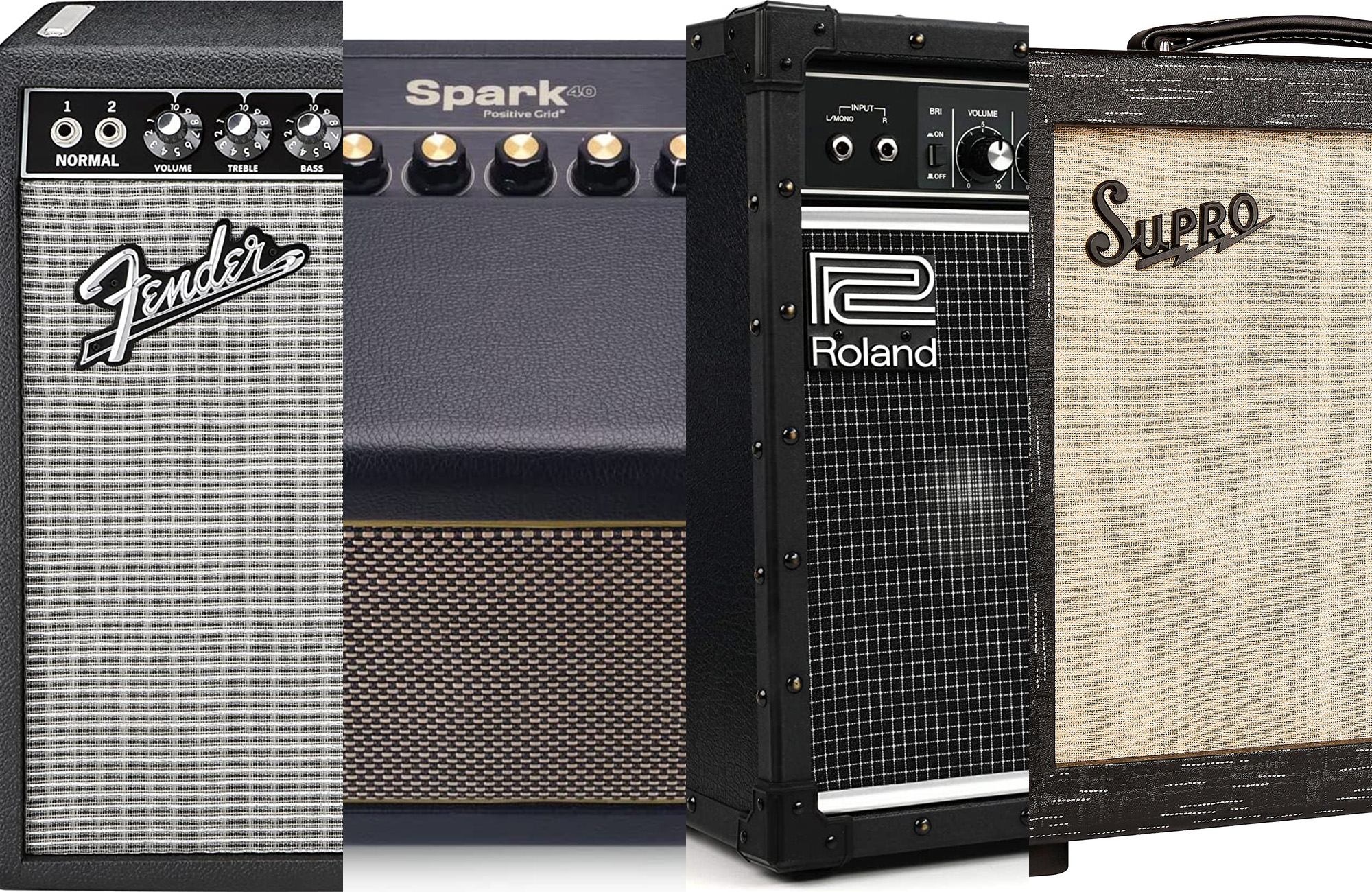
In the world of electric guitars, the guitar amplifier is as essential a piece of equipment as the instrument itself. Available in varieties big and small, with a range of tone and circuitry options, guitar amps allow players to explore the creative bounds of the electric guitar’s capabilities on their own terms. Whether you’re looking for a portable guitar amp that packs a punch, a clean amp for effects, a small tube amp that delivers warm overdrive, or a classic amp that does a little bit of everything, this list of the best guitar amps has something for every player and every scenario.
- Best overall: Fender ’65 Deluxe Reverb
- Best small: Supro 1612RT Amulet
- Best for practice: Roland JC-40
- Best under $500: ZT Amplifiers LunchBox Reverb Combo Amp
- Best budget: Positive Grid Spark 40-Watt Amp
How we chose the best guitar amps
When selecting the best guitar amps, we combined personal musical and production experience, the opinion of trusted peers, published critics, and online user impressions. We assembled this list of the best guitar amps with a focus on versatility and a secondary emphasis on brand reputation. Not every guitar amp is naturally suited to every genre of music or task, so we took care to choose the most sonically and creatively flexible guitar amps for each category based on their design and sound-sculpting abilities. We also included tube-based and solid-state designs to represent a wide range of tonal options. And we singled out a few items for their travel-friendly size.
The best guitar amps: Reviews & Recommendations
Not everyone has the space or plays the right style to justify investing in a Marshall stack (except maybe this one). But you’ve got one of the best electric guitars (or best electric guitars under $500), and you’re ready to kick out the jams, so here are our well-toned selections for best guitar amps.
Best overall: Fender ’65 Deluxe Reverb
Best overall
Fender ’65 Deluxe Reverb
Pros
- All-tube design delivers a wide range of classic tones
- Built-in tube-powered reverb and tremolo
- Multiple input channels for added flexibility
Cons
- Moderately heavy
Why it made the cut: The Fender ’65 Deluxe Reverb delivers legendary warm electric guitar tone and plenty of volume, making it a great all-around choice for stage and studio applications.
Specs
- Type: Tube
- Power: 22 watts
- Speakers: 1 x 12-inch
- Effects: Reverb, vibrato
- Dimensions: 17.5 x 24.5 x 9.5 inches (H x W x D)
- Weight: 42 pounds
The iconic Fender ’65 Deluxe Reverb is an industry-favorite combo guitar amp known for its crisp clean tones, gritty tube overdrive, and tonal flexibility at a wide range of volumes that make it a perfect vehicle for playing rock, jazz, blues, country, and many other styles. The ’65 Deluxe Reverb is the mid-sized offering in Fender’s historically inspired black panel line, which includes the ’65 Princeton Reverb and ’65 Twin Reverb. It comes with a 12-inch Jensen speaker and 22 watts of power that give it ample flexibility and headroom in recording and live applications alike. A classic tube amp through and through, the Deluxe is powered by a total of nine valves and includes built-in tremolo, spring reverb, and a two-band EQ for a variety of lush tones and sound sculpting options.
While the Fender ’65 Deluxe Reverb features a well-rounded design that balances power and size, its tube-based architecture includes plenty of transformers and other dense electronic components that make it considerably heavy. Still, it can handle the road miles (as shown in the above photo). If you’re looking for the same Fender black panel tone and design philosophy in a slightly easier-to-carry package, the 34-pound ’65 Princeton Reverb is a fantastic alternative that’s just as suitable for studio and stage applications with a slightly brighter and quieter sound profile.
Best small: Supro 1612RT Amulet
Best small
Supro 1612RT Amulet
Pros
- Adjustable power offers tube overdrive at any volume
- Very wide tonal palette with built-in EQ, reverb, and tremolo
- Compact design travels well
Cons
- Midrange-forward tone may be too dark for some players
Why it made the cut: The Supro 1612RT Amulet offers plenty of volume and selectable wattage for a variety of overdriven tones in a portable package.
Specs
- Type: Tube
- Power: 15 watts (switchable to 5 watts and 1 watt)
- Speakers: 1 x 10-inch
- Effects: Reverb, vibrato
- Dimensions: 17.5 x 17 x 8 inches (H x W x D)
- Weight: 28.9 pounds
After making a name for itself from the 1930s through the 1950s, legendary guitar manufacturer Supro went quiet. However, the brand was revived in 2013, and Supro returned in 2020 with a new line of stylish guitar amps that pair vintage tone and character with modern features. The 1612RT Amulet is one of the best compact tube amplifiers in Supro’s new product line, with a 10-inch Celestion speaker and three-way selectable wattage that allow it to deliver a huge range of clean and overdrive tones at any volume.
While the Amulet sounds relatively midrange-heavy and lacks some low bass response due to its 10-inch speaker, the amp’s sound is incredibly smooth and balanced for its compact size, aided further by its onboard bass and treble adjustment knobs. It’s a bit lighter than other 10-inch tube amplifiers of similar power ratings, like the Fender ’65 Princeton Reverb, making it a great option for traveling without sacrificing volume. If you don’t need the extra volume from the Amulet’s 15 watts of power or the switchable wattage feature, the 5-watt Supro Delta King 10 has a similar design and tone in an even lighter and more affordable package.
Best for home use: Roland JC-40 Jazz Chorus
Best for home use/practice
Roalnd JC-40 Jazz Chorus
Pros
- Lush clean tones and ample volume in a home-friendly package
- Stereo speakers and inputs are ideal for use with effects
- Built-in chorus, reverb, vibrato, and distortion
Cons
- Produces audible hiss at high volumes
- Small speakers lack deep bass response
- Doesn’t include a footswitch for built-in effects
Why it made the cut: This classic solid-state guitar amp features some of the best clean tones on the market and comes equipped with stereo speakers and lots of connectivity options, making it a great choice for at-home practice and recording.
Specs
- Type: Solid state
- Power: 40 watts
- Speakers: 2 x 10-inch
- Effects: Reverb, vibrato, chorus, distortion
- Dimensions: 17.2 x 23.3 x 9.9 inches (H x W x D)
- Weight: 34.8 pounds
Roland’s Jazz Chorus line of solid-state amplifiers was an instant hit with the introduction of the JC-120 in 1975, which offered tons of clean headroom and stereo effects in an easier-to-maintain alternative to the tube amplifiers of the time. Weighing in at 34.8 pounds, the Roland JC-40 Jazz Chorus packs the same rock-solid build quality and pristinely clean tone of its predecessors into a home-friendly package with a few modern appointments that make it a very flexible tool for creativity. In addition to including built-in reverb, vibrato, chorus, and distortion effects, the JC-40 features two front panel stereo inputs, a headphones output, and a stereo line output alongside a dedicated effects loop in the rear; these connectivity options make it one of the best guitar amplifiers for integrating with an existing home recording setup. The JC-40’s ultra-clean solid-state design also plays very well with outboard effects, allowing players to access their existing pedals’ full depth and character.
While the Jazz Chorus line of amps is undoubtedly some of the cleanest on the market, some users have complained about the JC-40’s noise floor and audible hiss. In our tests, we didn’t hear the amp produce any more hiss than you might hear from a normal tube amp, but the effect can vary wildly depending on what effects you’re running into the amp and whether the JC-40’s brightness or distortion features are engaged. The JC-40’s 10-inch speakers are also a bit lacking in the lowest frequencies of the sonic spectrum, giving the amp an overall brighter tone than its larger siblings.
Best under $500: ZT Amplifiers LunchBox Reverb Combo Amp
Best under $500
ZT Amplifiers LunchBox Reverb Combo Amp
Pros
- 100 watts of power provides enough volume for stage applications
- Very lightweight and compact
- Speaker extension and headphone outputs for expandability
Cons
- Relative lack of low-bass frequencies
Why it made the cut: The ZT LunchBox packs a remarkable 100 watts of power into its compact and portable 9.5-pound design.
Specs
- Type: Solid state
- Power: 100 watts
- Speakers: 1 x 6.5-inch
- Effects: Reverb
- Dimensions: 7.5 x 9.8 x 5.5 inches (H x W x D)
- Weight: 9.5 pounds
The ZT LunchBox is one of the most powerful small amps on the market, with a generous 100 watts of amplification that give it the ability to hold its own in loud rehearsals and performances despite weighing only 9.5 pounds. To keep it small and lightweight, the LunchBox features a solid-state design with a single 6.5-inch speaker and basic onboard tone controls, including a two-band EQ plus an integrated reverb. This gives the LunchBox a moderately wide range of tone and volume capabilities in a small package, making it an excellent option for commuting musicians or those who live and work in small spaces.
Because of its relatively small cabinet and speaker, the ZT LunchBox has a midrange-forward sound that is somewhat lacking in low-frequency fullness. This can be mitigated using the amp’s 8-ohm speaker output, which connects to a separately-sold companion extension cabinet to boost the rig’s overall volume and low-end punch. The LunchBox also features a built-in headphones output and a switch that mutes the built-in speaker, making it a solid option for silent practice applications.
Best budget: Positive Grid Spark 40-Watt Amp
Best budget
Positive Grid Spark 40-Watt Amp
Pros
- Over 10,000 built-in sound presets with effects
- Backing tracks and chord recognition through the companion app
- Functions as a guitar recording interface
Cons
- Low-mid heavy speaker sound profile
- Not battery-powered
- App required for some functionality
Why it made the cut: The Positive Grid Spark features a huge number of effects and tonal options combined with recording interface functionality in an affordable package.
Specs
- Type: Solid state
- Power: 40 watts
- Speakers: 2 x 4-inch
- Effects: Reverb, distortion, modulation, delay, compressor
- Dimensions: 7.5 x 13.8 x 7 inches (H x W x D)
- Weight: 11.5 pounds
The Positive Grid Spark is a compact amp with plenty of unique features and creative flexibility despite its budget-friendly $300 price tag. In addition to being a portable modeling guitar amp with over 10,000 accessible effects presets, the Spark also functions as a Bluetooth companion speaker for playing along with backing tracks and a USB-enabled audio interface for recording your guitar straight to a computer. This makes the Spark a uniquely appealing option for beginning guitarists who want to learn their favorite songs or begin sketching out their own original recordings in GarageBand.
The Spark features 40 watts of power, weighs just under 12 pounds, and packs two 4-inch speakers, giving it ample volume with a slightly muffled sound that can be sculpted and adjusted using the amp’s onboard EQ or through the Spark smartphone app. While the Spark app provides access to many of the amp’s basic features and lets you browse and load its virtual signal chains, we’d prefer if the amp relied a bit less on the smartphone app and offered a more robust standalone user experience out of the box. Still, after using the app to make some global adjustments to the amp’s sound, the Spark proves to be an inspiring option for creativity and home use. (And while the 40-watt Spark is plenty portable, the Spark MINI, its smaller sibling, is even more so, making it a perfect party speaker if you’re the type that likes to shred at a shindig.)
Things to consider when picking from the best guitar amps
Do you prefer tube or solid-state?
Arguments for and against tube and solid-state guitar amps have kept many guitarists up at night, but choosing between them is a simple decision that should come down to what type of music you’ll be playing through the amp. Due to their design, tube circuits provide a natural, ear-pleasing harmonic overdrive when pushed to loud volumes, and this “positive distortion” is perfect for blues, rock, and other styles that require a bit of analog grit. Solid-state amp circuits, however, aim to produce none of this natural distortion and are designed to sound as clean as possible at high volumes, making them an excellent choice for jazz and an ideal pairing for players with a large collection of outboard effects and guitar pedals.
How loud should it be?
Guitar amp volume corresponds with many design factors, including wattage and speaker size, and guitar amps with a power rating around 20 watts and speakers between 6.5 and 10 inches should suffice for the vast majority of home and recording applications. If you use an amp for rehearsals alongside loud instruments like bass and drums, outdoors, or in large performance spaces, a more flexible design like the Roland JC-40 Jazz Chorus or Fender ’65 Deluxe Reverb will provide you with ample volume to be heard.
Does it need to be portable?
Guitar amps are notoriously large and heavy, so if you’re looking for a travel-friendly option, you’ll want to consider a lightweight solid-state design made specifically to be transportable, like the ZT Amplifiers LunchBox Reverb Combo Amp or the Positive Grid Spark 40-Watt Amp. Remember that smaller amps typically produce less low-frequency sound, so you’ll be trading off a bit in the tone department in exchange for portability. If you have your heart set on a heavier tube-based design but still want something relatively easy to transport, the Fender ‘57 Custom Champ is a great-sounding option that weighs only 15 pounds.
FAQs
Guitar amps—from the brands we’ve featured and iconic amps from brands like MESA/Boogie, Vox, Orange, and Peavey, among others—cost anywhere from close to $200 to over $5,000.
Guitar amps can be stored freestanding in any room or in an enclosed space like a closet. Buying an amp cover or bag is a good idea for long-term storage, as it will provide some measure of protection against moisture and dust.
Guitar amps can last for a lifetime if cared for and properly maintained. Many electronic components within an amplifier circuit degrade over long periods and will require replacement after a few decades, and tubes should be replaced roughly every two years on average.
Guitar amps can definitely be used outdoors, and their sound can travel very far, making it advisable to get permission from those around you before you let loose. Sound tends to diffuse more in outdoor spaces, so in a performance scenario, you’ll want to pick an amp on the louder side, like the Fender ’65 Deluxe Reverb or a Roland JC-120 Jazz Chorus.
Final thoughts on the best guitar amps
- Best overall: Fender ’65 Deluxe Reverb
- Best small: Supro 1612RT Amulet
- Best for practice: Roland JC-40
- Best under $500: ZT Amplifiers LunchBox Reverb Combo Amp
- Best budget: Positive Grid Spark 40-Watt Amp
We love the tonal flexibility, volume range, and natural overdrive of the Fender ’65 Deluxe Reverb, one of the most well-rounded tube guitar amps for big and small applications. The Roland JC-40 Jazz Chorus is a slightly quieter solid-state design with a pristine clean tone that makes it best suited for recording and practice use at home, though it also sounds great onstage in front of a microphone. If you’re looking for a smaller amp, the Supro 1612RT Amulet is the best small tube amp we’ve tested, thanks to its flexible tone and switchable wattage. At the same time, we prefer the solid-state ZT Amplifiers LunchBox Reverb Combo Amp for applications where maximum volume is required in the smallest package possible.
